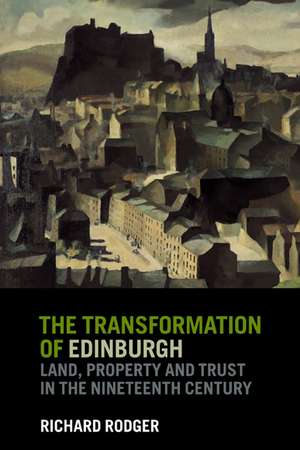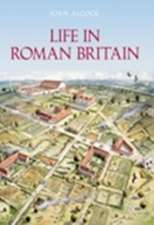The Transformation of Edinburgh: Land, Property and Trust in the Nineteenth Century
Autor Richard Rodgeren Limba Engleză Paperback – 24 mar 2004
| Toate formatele și edițiile | Preț | Express |
|---|---|---|
| Paperback (1) | 285.85 lei 6-8 săpt. | |
| Cambridge University Press – 24 mar 2004 | 285.85 lei 6-8 săpt. | |
| Hardback (1) | 978.20 lei 6-8 săpt. | |
| Cambridge University Press – 24 oct 2001 | 978.20 lei 6-8 săpt. |
Preț: 285.85 lei
Nou
Puncte Express: 429
Preț estimativ în valută:
54.70€ • 57.26$ • 45.26£
54.70€ • 57.26$ • 45.26£
Carte tipărită la comandă
Livrare economică 05-19 aprilie
Preluare comenzi: 021 569.72.76
Specificații
ISBN-13: 9780521602822
ISBN-10: 0521602823
Pagini: 564
Ilustrații: 59 b/w illus. 21 maps
Dimensiuni: 152 x 230 x 32 mm
Greutate: 0.83 kg
Ediția:Revised
Editura: Cambridge University Press
Colecția Cambridge University Press
Locul publicării:Cambridge, United Kingdom
ISBN-10: 0521602823
Pagini: 564
Ilustrații: 59 b/w illus. 21 maps
Dimensiuni: 152 x 230 x 32 mm
Greutate: 0.83 kg
Ediția:Revised
Editura: Cambridge University Press
Colecția Cambridge University Press
Locul publicării:Cambridge, United Kingdom
Cuprins
Part I. Urban Frameworks: 1. Introduction; 2. Institutional power and landownership: the nineteenth-century inheritance; 3. Victorian feudalism; 4. Building capital: Trusts, loans and the kirk; 5. The building industry and instability; Part II. Building Enterprise and Housing Management: 6. The search for stability; 7. Industrial suburb: developing Dalry; 8. The genesis of a property owning democracy?; 9. Landlord and tenant; 10. Post-script: 'Firmiter et Durabile': the construction of legitimacy; Part III. Complementary Visions of Society: 11. Co-operation and mutuality: 'the colonies' and the Edinburgh Co-operative Building Company; 12. Civic consciousness, social consciences and the built environment; 13. Adornment, ego and image: the decoration of the tenement; 14. Conclusion: Re-inventing the city.
Recenzii
'A unique undertaking … by any standards a remarkable piece of scholarship.' Stana Nenadic, H-Urban
'This is the most important book on post-1760 Edinburgh since A. J. Youngson's The Making of Classical Edinburgh (1966) … Rodger takes us on a fascinating journey.' John Byrom
'This is a path-breaking book that demands to be read, and re-read, by all those with a serious interest in the material life and culture of the nineteenth- and early twentieth-century British, European, and North American city.' Bill Luckin, The American Historical Review
'Richard Rodger's book is a real work of art as well as of devoted craft. It is not simply an economic history, but a cultural account too. The whole is presented in a highly readable form, with superb illustrations, maps and diagrams …'. Scottish Affairs
'A massive amount of archival material is used alongside official reports and contemporary newspaper/journal articles, to present a comprehensive account of the impact of Victorian landlordism, and the reinvention account of feudalism, on Edinburgh society. Rodger expertly brings out the complexities involved in private development in land, and the relationship between landlords and tenants, and his case studies of individual suburbs - especially that of Dalry - give further illustrations for the reader, and demonstrate once more the relevance of the late-century land reformers to the Scottish urban population … the clarity of the narrative, and the supporting illustrations, ensures that the reader's attention is kept throughout. The Transformation of Edinburgh should not only be required reading for social and urban historians, but also for the municipal powers-that-be in modern day cities.' Scottish Economic and Social History
'… impressively illustrated and littered with helpful tables, charts, and maps, which offer the reader significant assistance …'. Business History Review
'This book will clearly constitute essential reading for British urban historians, but its significance extends also to those with an interest in the legal, social and economic ramifications of urban growth in the nineteenth century. Based on a formidable body of archival research this volume marks a major new contribution to the study of British urbanisation from the perspective of land and property development, and may well provide a model for future town and city studies.' Constitution History
'The work is original and unlikely to be superseded … This work should be in every university library and on the shelves of scholars of nineteenth-century cities.' Economic History Review
'This is the most important book since A. J. Youngson's The Making of Classical Edinburgh and in its breadth and depth of coverage, sophisticated arguments and mastery of difficult primary sources, may be said to exceed the achievement of that pioneering work.' Book of the Old Edinburgh Club
'Richard Roger has written a marvellous book showing just how complex and implicit trust relationships usually are, in this case in the building of a great city.' Urban History
'… Rodger's book offers fascination through its detailed research and thoughtful insights … One of the great delights of the book is the numerous strands within the major themes.' Urban Morphology
'It is evident that all of Edinburgh's major archives have been fully exploited in the production of this work, and that the research included is freshly culled. This book is the definite statement on building and property development in Edinburgh within this period and will remain so for many years to come.' Journal of Urban History
'This is the most important book on post-1760 Edinburgh since A. J. Youngson's The Making of Classical Edinburgh (1966) … Rodger takes us on a fascinating journey.' John Byrom
'This is a path-breaking book that demands to be read, and re-read, by all those with a serious interest in the material life and culture of the nineteenth- and early twentieth-century British, European, and North American city.' Bill Luckin, The American Historical Review
'Richard Rodger's book is a real work of art as well as of devoted craft. It is not simply an economic history, but a cultural account too. The whole is presented in a highly readable form, with superb illustrations, maps and diagrams …'. Scottish Affairs
'A massive amount of archival material is used alongside official reports and contemporary newspaper/journal articles, to present a comprehensive account of the impact of Victorian landlordism, and the reinvention account of feudalism, on Edinburgh society. Rodger expertly brings out the complexities involved in private development in land, and the relationship between landlords and tenants, and his case studies of individual suburbs - especially that of Dalry - give further illustrations for the reader, and demonstrate once more the relevance of the late-century land reformers to the Scottish urban population … the clarity of the narrative, and the supporting illustrations, ensures that the reader's attention is kept throughout. The Transformation of Edinburgh should not only be required reading for social and urban historians, but also for the municipal powers-that-be in modern day cities.' Scottish Economic and Social History
'… impressively illustrated and littered with helpful tables, charts, and maps, which offer the reader significant assistance …'. Business History Review
'This book will clearly constitute essential reading for British urban historians, but its significance extends also to those with an interest in the legal, social and economic ramifications of urban growth in the nineteenth century. Based on a formidable body of archival research this volume marks a major new contribution to the study of British urbanisation from the perspective of land and property development, and may well provide a model for future town and city studies.' Constitution History
'The work is original and unlikely to be superseded … This work should be in every university library and on the shelves of scholars of nineteenth-century cities.' Economic History Review
'This is the most important book since A. J. Youngson's The Making of Classical Edinburgh and in its breadth and depth of coverage, sophisticated arguments and mastery of difficult primary sources, may be said to exceed the achievement of that pioneering work.' Book of the Old Edinburgh Club
'Richard Roger has written a marvellous book showing just how complex and implicit trust relationships usually are, in this case in the building of a great city.' Urban History
'… Rodger's book offers fascination through its detailed research and thoughtful insights … One of the great delights of the book is the numerous strands within the major themes.' Urban Morphology
'It is evident that all of Edinburgh's major archives have been fully exploited in the production of this work, and that the research included is freshly culled. This book is the definite statement on building and property development in Edinburgh within this period and will remain so for many years to come.' Journal of Urban History
Notă biografică
Descriere
This is a study of the physical transformation of Edinburgh in the nineteenth century.














